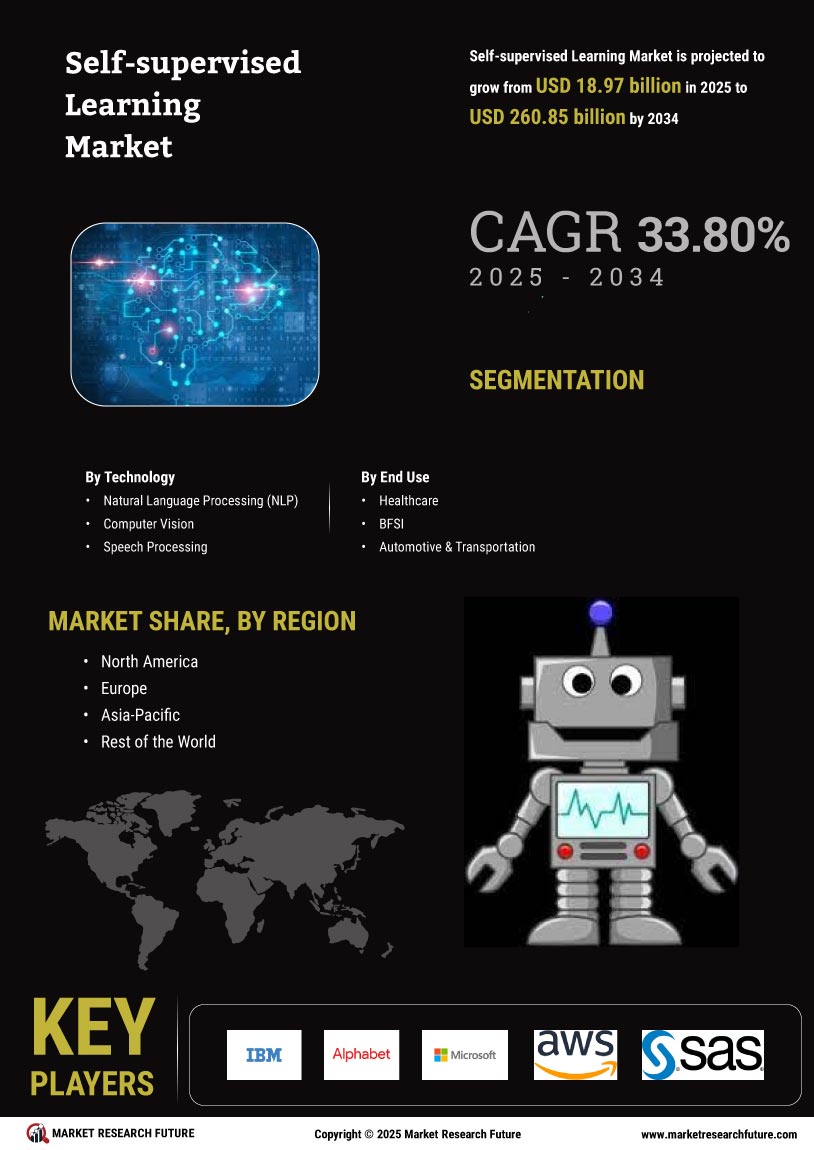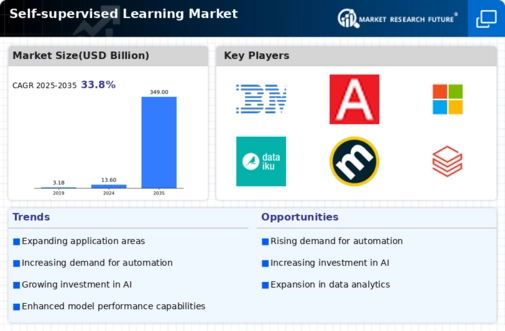Increased Demand for Automation
The Self-supervised Learning Market is experiencing a notable surge in demand for automation across various sectors. Organizations are increasingly seeking to enhance operational efficiency and reduce human intervention in data processing. This trend is particularly evident in industries such as finance, healthcare, and manufacturing, where the need for rapid data analysis and decision-making is paramount. According to recent estimates, the automation market is projected to reach USD 200 billion by 2026, indicating a strong correlation with the growth of self-supervised learning technologies. As businesses strive to leverage vast amounts of unlabelled data, self-supervised learning emerges as a pivotal solution, enabling systems to learn from data without extensive human oversight. This shift towards automation not only streamlines processes but also fosters innovation, positioning self-supervised learning as a critical component in the evolving landscape of artificial intelligence.
Growing Volume of Unlabelled Data
The Self-supervised Learning Market is significantly influenced by the exponential growth of unlabelled data generated across various platforms. With the proliferation of digital content, organizations are inundated with vast amounts of data that remain unlabelled, making traditional supervised learning approaches less feasible. It is estimated that over 80 percent of data generated today is unlabelled, presenting a unique opportunity for self-supervised learning methodologies. These techniques allow models to learn from this unlabelled data, extracting valuable insights without the need for extensive manual annotation. As businesses recognize the potential of harnessing unlabelled data, the demand for self-supervised learning solutions is expected to rise. This trend not only enhances the efficiency of data utilization but also drives innovation in machine learning applications, positioning self-supervised learning as a cornerstone in the future of artificial intelligence.
Advancements in Computational Power
The Self-supervised Learning Market is benefiting from significant advancements in computational power, which are enabling more complex and efficient learning algorithms. The rise of powerful GPUs and cloud computing resources has made it feasible to train large-scale models on extensive datasets. This technological evolution is crucial for self-supervised learning, as it often requires substantial computational resources to process and analyze vast amounts of unlabelled data. Recent reports indicate that The Self-supervised Learning is expected to reach USD 832 billion by 2025, further facilitating the deployment of self-supervised learning models. As organizations invest in advanced computational infrastructure, the capabilities of self-supervised learning are likely to expand, allowing for more sophisticated applications across various industries, including natural language processing and computer vision.
Increased Focus on Data Privacy and Security
The Self-supervised Learning Market is increasingly shaped by the growing emphasis on data privacy and security. As organizations collect and process vast amounts of data, concerns regarding data breaches and compliance with regulations such as GDPR and CCPA have intensified. Self-supervised learning offers a potential solution by enabling models to learn from data without exposing sensitive information. This approach not only mitigates privacy risks but also aligns with regulatory requirements, making it an attractive option for businesses. The market for data privacy solutions is projected to grow significantly, with estimates suggesting a value of USD 150 billion by 2028. As organizations prioritize data protection, the adoption of self-supervised learning techniques is likely to increase, positioning them as a vital component in the development of secure AI applications.
Rising Investment in Artificial Intelligence
The Self-supervised Learning Market is witnessing a surge in investment in artificial intelligence technologies, which is driving the demand for innovative learning methodologies. As businesses recognize the transformative potential of AI, funding for AI startups and research initiatives has escalated. In 2025, global investment in AI is projected to exceed USD 100 billion, reflecting a robust interest in developing advanced machine learning techniques, including self-supervised learning. This influx of capital is likely to accelerate research and development efforts, fostering the creation of novel algorithms and applications. As organizations seek to leverage AI for competitive advantage, self-supervised learning is positioned to play a crucial role in enhancing the capabilities of AI systems, thereby contributing to the overall growth of the market.





















Leave a Comment